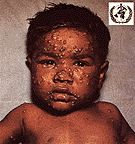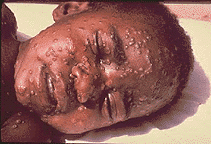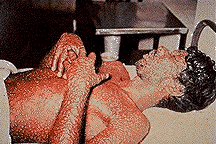
|
|
OTHER SITES OF INTEREST Anthrax Pictures Anthrax Symptoms God Bless America lyrics Statue of Liberty pictures Free Patriotic Screensavers |
Smallpox Pictures Click images to see larger versions - Thanks to the CDC for the pictures. |






|
|
|
It is generally believed that Smallpox has been eradicated from our world. The last case of endemic smallpox was reported in 1977 from Somalia. In 1980 the World Health Organization officially declared that smallpox had been eliminated worldwide as a result of a global vaccination and eradication program. The only known remaining samples of smallpox virus are two research laboratories - located in the United States and Russia.
Smallpox was a relatively less contagious disease whose transmission required close contact. Fever and macular rash appeared after an average incubation period of 12 days, with a progression to typical vesicular and pustular lesions over 1 to 2 weeks. Clinical features This disease is spread by inhalation of air droplets or aerosols. Twelve to 14 days after catching infection, the patient becomes febrile and has severe aching pains.. Some 2 to 3 days later, a papular rash develops over the face and spreads to the extremities. The rash soon becomes vesicular and later, pustular. The patient remains febrile throughout the evolution of the rash and experiences considerable pain as the pustules grow and expand. Gradually, scabs form, which eventually separate, leaving pitted scars. In severe cases death usually occurs during the second week. Before the eradication of the smallpox this disease was confused frequently with chickenpox mainly during the early stage. Smallpox Symptoms and Complications: All smallpox lesions develop at the same pace and, on any part of the body, appear identical. Chickenpox lesions are much more superficial and develop in crops. With chickenpox, scabs, vesicles, and pustules may be seen simultaneously on adjacent areas of skin. Moreover, the rash in chickenpox is more dense over the trunk which is reverse with smallpox. Chickenpox lesions are almost never found on the palms or soles. In 5-10% of the patients the disease takes a malignant shape and the patients dies in 5-7 days. There may be bleeding in the skin and other parts of the body especially the intestines. Medical Info: Smallpox Vaccination" The only protection against this disease is vacination. Vaccination before exposure or within 2 to 3 days after exposure affords almost complete protection against disease. Vaccination as late as 4 to 5 days after exposure may protect against death. Because smallpox can only be transmitted from the time of the earliest appearance of rash, early detection of cases and prompt vaccination of all contacts is very important in the spread of this disease. The Smallpox Vaccine" The vaccine against smallpox is made from vaccinia virus Its origin is uncertain, but it was probably derived from cowpox virus, variola virus, or a hybrid of the two. Experience has proven the effectiveness of live vaccinia-virus vaccine. Percutaneous administration of vaccinia virus vaccine results in protective immune responses in more than 95 percent of primary vaccines. Formation of a pustule and scab at the site of inoculation is indicative of immunity. Because immunity wanes after 10 to 20 years, revaccination every 10 years is recommended for continued protection. Routine smallpox vaccination was discontinued in 1971 and has not been required for international travel since 1982. However, use of vaccinia viruses for use in vaccines against other infectious agents or as immunotherapy against malignant diseases has led to the recommendation that laboratory and health care employees working directly with vaccinia virus be considered for vaccination. Selected groups that may be exposed to poxviruses (e.g., some military personnel and individuals who work with animals) should also be vaccinated. |
. . . .